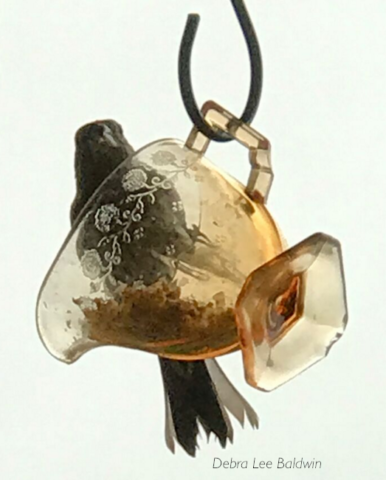
House finch on a glass creamer repurposed as a bird feeder.
My pastimes of thrifting and birding inspired me to create bird feeders from repurposed items. It all began a few months ago when I was given a commercial feeder to trial. Its peaked roof is “cute” (to quote a friend), but it’s made of plastic (shudder) and is a color I call “hose green”—a blue-green never found in nature.
It also was too efficient. House finches (linnets) emptied it quickly, and one cup of seed mix is all I wanted to give them daily. Plus, watching these mice of the bird world stuff themselves became boring. All they did was sit, eat, and lunge at rivals who wanted to share the feeder.
I read up on wild birds—their habits, what species frequent the foothills of inland Southern CA, and what they eat. I also researched the ideal bird feeding experience for both birds and humans. Feeders should be located where you can watch easily from indoors, and where birds can dart into nearby branches; and well above the ground so cats can’t pounce and it’s difficult for rodents to help themselves.
So with bird-feeding in mind, I trolled estate sales and thrift shops. I decided to use inexpensive objects I found in abundance: wrought iron candleholders with metal rings for votives in glass cups. It seemed that such shallow vessels would hold the right amount of bird seed, and metal rods in pleasing ornamental shapes would make good perches.
Although I planned just one feeding station at first, I went on to create three on the deck outside my kitchen and dining room. Much thought, creativity and fun went into modifying them to maximize their appeal to me and to my feathered guests.
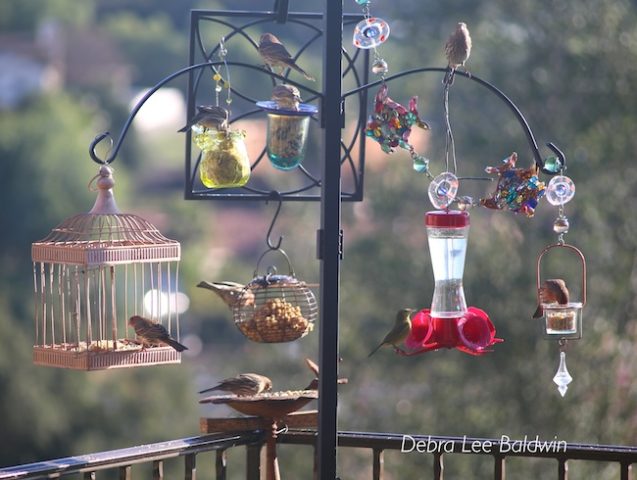
Bird feeders on a plant stand create a feeding station. Wire ball at center contains suet. Birds are house finches and, at the hummingbird feeder, an orange-crown warbler (also shown below).
Station One, positioned on the far corner of the deck, uses a 7-foot-tall wrought iron plant stand designed to hold hanging baskets of plants. On one hook is a square wrought iron candleholder with a glass candle cup that I initially worried might be too deep. I decided to go ahead and try it—after all, why shouldn’t those greedy finches work for their food? Sure enough, they’ll feed vertically if need be—beaks straight down and tail feathers skyward.
This made me wonder what other antics and acrobatics house finches might do. Although I stopped short of adding a maze, I decided the ideal feeder needs an entertainment factor.
Also on the plant stand I hung an old wire birdcage. It’s still my favorite feeder. I love watching wild birds eagerly enter the cage, the door of which I’ve wired open to avoid accidentally trapping one. (I’ve also spread the wires a bit on the opposite side, so they have a second exit. They enter the cage that way, too.) Once a plump mourning dove, seduced by the scent of peanuts, caged itself.
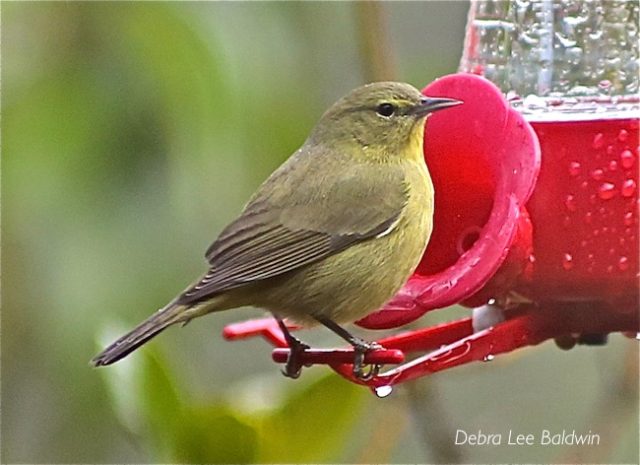
Next came a hummingbird feeder. Imagine my surprise when an adorable chartreuse bird about 4 inches long (compared to 5 inches for the house finches) began frequenting it, along with the expected Anna’s hummers. I’m pretty sure my “little green guy” is an orange-crowned warbler. Score!
I wired a tray onto the deck railing, and filled it with peanuts for doves and jays. White crowned sparrows came next, gleaning bits that fell on the deck or patio below.
Station Two, inspired by the birds’ lack of fear of my hulking house and the moving shadows within, is beneath the eaves right outside the kitchen window. In case you’re wondering, none of the birds has hit the glass. “They can tell it’s a barrier,” a Wild Birds Unlimited employee assured me. This station consists mainly of wrought iron candle holders linked together. I had to scrounge for S-hooks. When installing bird feeders, one never has enough.
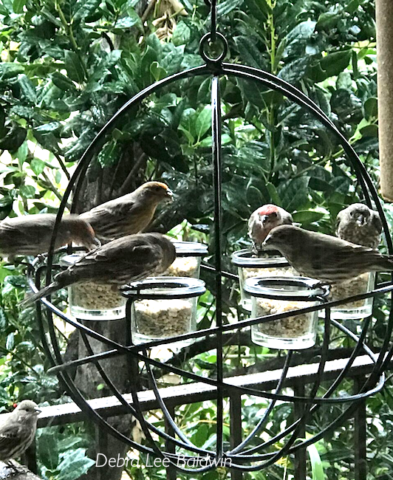
House finches won’t share a feeder, but they’re fine crammed together if each has its own. Watch the video.
Happy discovery: When each finch has its own seed-filled cup, it doesn’t mind being close to a rival finch. At a circular candleholder with seating for six, each place is soon filled, there’s a queue along the deck rail, and others observe from tree branches. That is, when they deign to visit.
House finches come and go like adolescents with cars. They arrive all at once, boisterous and noisy; pushing, flapping, and ravenous; each with a wary eye out for the Lady of the House. When she appears, they take off with a whoosh, offering no thanks, apologies, or stacking of dishes.

In my tea party themed station, glass feeders make the birds easier to see.
Station Three, installed earlier today, has a tea-party theme. I nailed two matching S-shaped candleholders horizontally beneath the eaves, then wired chains to them, with hooks to hang tea cups, a sugar bowl and creamer, a tea pot, and a serving tray with a handle. The initial version used pretty china cups, but I soon switched to glass. Being translucent, glass is like solid air, so it suits an airy feeder, plus you can see the birds better and how much seed is left. I still need a transparent tea pot. Which is to say, I really need to go thrifting. Soon.
Tips for creating a feeding station or making your own feeders:
— Be patient. It may take birds several days to find a feeder.
— House finches are prevalent and arrive in pairs (male and female). If you leave food sitting out, even if it’s not in a feeder, they’ll find it. Although wild birds are endearing when hopping on patio furniture, they do make a mess.
— Visit your local Wild Birds Unlimited store. The employees are friendly, knowledgable and happy to share information. Pick up a bag of WBU’s “No Mess Seed Mix.” (Nuts and seeds already shelled.)
— Add a birdbath. They’ll drink from it, splash around in it, and it’ll attract more birds (not all want seeds; many eat insects).
— Expect a bonanza of birds on a rainy day, which also is a great time to install a new feeding station.
— Hang breakable objects so they won’t hit each other when jolted by wings or the wind.
— At dusk, bring indoors food that might attract nocturnal varmints like rats and opossums.
— In winter, add suet (from a bird store or garden center) to your feeding station.
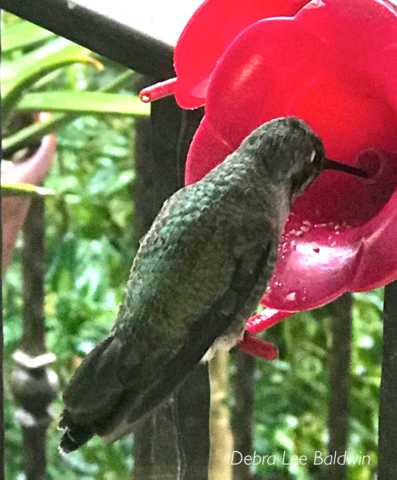
Female Anna’s hummingbird
— Don’t add food coloring to hummingbird syrup. The red of the feeder is enough to attract them.
— Keep hummingbird feeders clean; mildew and fungus can harm the birds.
— When placing a feeder, keep in mind that whatever is below it will be showered with bird droppings and seed husks.
— Hardware stores sell black S-hooks in the garden department; regular S-hooks (which are cheaper but silver colored) in the hardware section. You’ll also need chain (sold by the foot), flexible wire, and a wire cutter.
— Enrich your experience by identifying the birds that visit your feeders. Obtain a Sibley’s birding guide specific to your region. (No, the Internet and Google aren’t enough.)
— Get a good pair of binoculars (mine are Polaris Optics). They’re a portal to another world, both at feeders and beyond.
